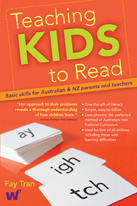About teaching kids to read
Over the past few years, Wilkins Farago has built a reputation for publishing children’s picture books from around the world.
Our next book couldn’t be more different. It’s adult nonfiction, has only minimal illustration and the author is Australian. But it’s probably the most important book we’ve published so far.
The book is Teaching Kids to Read: Basic Skills for Australian & New Zealand parents and teachers by Fay Tran, and here’s why it’s going to get parents and teachers all over Australasia very excited.
New National Curriculum
November 2010 sees the launch of Australia’s new National Curriculum. This will establish for the very first time the level of education every child across Australia is entitled to receive.
One of the key features of the new National Curriculum will be the requirement that every child is taught how to read using the Phonics method. Fay Tran’s Teaching Kids to Read will be the only up-to-date Australian trade title that shows how to use this method.
Phonics is back
Those of you educated up until the 1970s may remember Phonics. It teaches children to recognise the sounds letters make and blend them together to read unfamiliar words. It works. This method was replaced during the 80s and 90s in most Australian schools by the Whole Language Method. It didn’t work so well.
Official statistics show that 7 million Australians aged 15 to 74 (46%) now have literacy skills below the “minimum required for individuals to meet the complex demands of everyday life and work.”
Last November, Australia’s Deputy PM and Education Minister Julia Gillard called an end to the Whole Language Method experiment, when she said:
Grammar is back. The reading wars are over, with a proper emphasis on Phonics.
This is the phonics book
So, Phonics is back, and how. A whole generation of teachers and parents has to learn to teach phonics all over again.
But how? Well, there’s only one Australian book that shows how anyone can teach kids to read using the phonics method and we’ve got it.
Teaching Kids to Read is a simple, easy-to-follow guide. Packed with case studies and all-important word and phonogram lists, we hope it will become the essential handbook.
A lifelong passion for literacy
A qualified Australian teacher and learning support specialist with over 25 years’ experience, Fay Tran never stopped teaching phonics, in spite of the professional pressures to stop doing so. Her lifelong passion has been to save children from reading failure. Now her knowledge and experience has been condensed into a 176-page book that can literally transform a child’s life.
Fay knows her stuff. One of the leading academic authorities on children’s literacy, Associate Professor Peter Westwood says this about Fay’s approach in his foreword to the book:
Her approach to their problems reveals a thorough understanding of how children learn.
The campaign to sell phonics
The campaign to reintroduce phonics to its rightful place in our schools and homes starts this August with the release of Teaching Kids to Read.
Fay will participate in a national media tour arranged by respected media specialists, Alan Davidson Publicity. A schedule of public appearances including a launch, school visits and panel sessions are also being planned.
It’s about more than book sales
There should be no industry more passionate about helping kids to read than the book industry: after all, without future readers we don’t have a business. However, publishing Fay Tran’s book has reminded me that teaching kids to read is about more than selling books.
As Fay says in her book:
Believe me, rescuing a child from reading failure is the most rewarding experience, and can have a huge impact on the child’s life.
In today’s society, a child who isn’t literate is a child left behind for life. Everything thereafter is a struggle: getting a job, reading instructions, using the internet, even reading the label of a medicine bottle. If, as Fay points out,
There is no reason – or indeed excuse – for schools today not to teach all children to read and write.
then there are moral reasons for reintroducing phonics, as well as economic ones.
For this reason, Teaching Kids to Read is a book we’re very excited about, and proud to be publishing in August.


